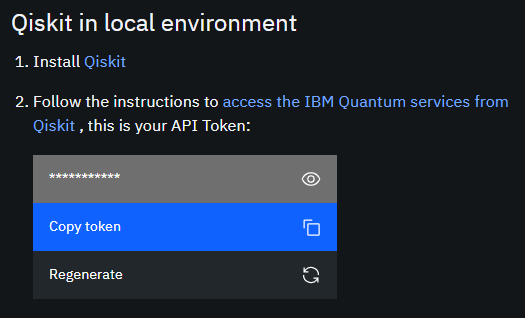python-for-physicists
A series of programming tutorials in Python aimed for physicists.
M08T05 - The Qiskit SDK
Cloud Computing meets Quantum Computers!
← [Previous] M08T04 - Algorithms
Qiskit is an open-source framework written in Python which provides access to quantum computing platforms for learning, as well as facilitates research on quantum computation. Together with the IBM Quantum Experience, it can be used to work with quantum computers at a level of circuits, pulses, and algorithms.
Installing the SDK
Setting Up the Python Environment
The Qiskit Software Development Kit (SDK) requires a 64-bit version of Python 3.5 or later and preferably a virtual environment to avoid dependency clashes with other installed packages.
Once you have set up Python, create a new environment for the latest version of Python 3.x.x via the following command:
conda create --name qcomp python=3
Once the environment is created, activate it using:
conda activate qcomp
Update the environment to download the latest packages:
conda update --all
Since qiskit is being maintained by the default Python package manager pip and does not yet have a conda source, we need to update pip to its latest version before installing qiskit. This can be done by executing:
pip install --update pip
Note: pip does not check for dependency clashes with previously installed packages; hence make sure you create a new environment for qiskit with a compatible version of Python.
Installating Qiskit Packages
Finally, install the latest version of the qiskit package along with visualiation functionality using:
pip install qiskit[visualization]
Once all packages and their dependencies are installed, check the version of qiskit installed via the following lines in the interactive mode:
>> import qiskit
>> qiskit.__version__
A one-liner command line alternative for the above step is:
python -c "exec(\"import qiskit\nprint(qiskit.__version__)\")"
Note: The Qiskit SDK comprises of four components (called elements) - Terra, Aer, Ignis, and Aqua - which talk to one another via API calls.
When qiskit.__version__ is called, the installed version of Terra is displayed in the output.
Implementing the SDK
IBM Quantum API Access Token
IBM Quantum Experience is a cloud-based platform to provide access to IBM’s prototype quantum processors. It offers a variety of graphical tools to create as well as run quantum algorithms and experiments on their quantum computers.
Create or Log In to you personal IBM Quantum Experience account from the official webpage.
Once logged in, select on the My Account option available under the Profile icon situated at the top-right corner (or alternatively, visit the My Account page in the same browsing environment).

Copy the IBM Quantum API access token from the page available under the Qiskit in local environment section.

To save the access token in Qiskit configuration file, type the following in the interactive mode, replacing api_access_token by the copied access token:
>> import qiskit as qk
>> qk.IBMQ.save_account('api_access_token')
The stored access token can be found inside the $HOME/.qiskit/qiskitrc file in Linux systems and in %UserProfile%/.qiskit/qiskitrc file in Windows systems.
Note: Unless mentioned otherwise, we will be using the acronym qk for qiskit.
Executing Locally
Since we are interested in debugging our scripts locally, we need classical simulators to mimic the quantum systems.
Such simulators rely on a qiskit.QuantumCircuit object which consists of the collection of qbits and cbits forming the circuit.
For example, a quantum circuit comprising of num_q qbits and num_c cbits can be written as:
qcirc = qk.QuantumCircuit(num_q, num_c)
The qiskit.Aer component comes with several backends to sumulate quantum circuits.
These local backends can be listed using:
>> qk.Aer.backends()
The required available backend (say the noisy quantum simulator, QASM, named qasm_simulator) can be run to simulate the quantum circuit using a job instance, which can be executed using:
be = qk.Aer.get_backend('qasm_simulator')
job = qk.execute(qcirc, backend=be)
Calling the result() method of the job instance returns the Result object containing the outcome of the execution.
Qiskit’s visualization tools can be used to plot the results of the simulated quantum circuit. A histogram plot of the probabilities of the final state can be obtained as:
>> import qiskit.visualization as qkv
>> qkv.plot_histogram(job.result().get_counts(qcirc))
Note: Unless mentioned otherwise, we will be using the acronym qkv for qiskit.visualization.
Executing in IBM Quantum
IBM Quantum allows access to its prototype quantum computers via cloud interfaces known as profiders.
These contain the backend objects for their quantum systems.
The list of backends available for a provider (e.g., for the ibm-q hub) can be obtained using:
>> be_provider = qk.IBMQ.get_provider('ibm-q')
>> be_provider.backends()
Depending upon the requirement, a specific backend available from the list (say ibmqx2) can be run to execute a quantum circuit:
>> be = be_provider.get_backend('ibmqx2')
>> job = qk.execute(qcirc, backend=be)
Since this job is run in a shared environment, it is queued until the system is available.
To view the progress of the job, qiskit.tools module features a monitor which can be implemented as:
>> qk.tools.job_monitor(job)
Upon completion, this displays an output of the form:
Job Status: job has successfully run
The Qiskit SDK notebook implements all the above functions stepwise, displaying the results of both the classical simulation and the quantum execution.
Also, the qiskit-tutorials repository contains an awesome collection of IPython notebooks.

